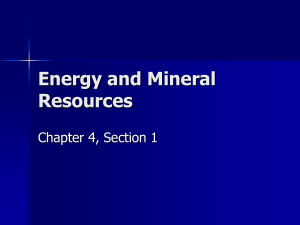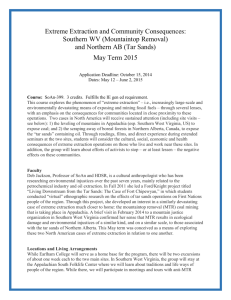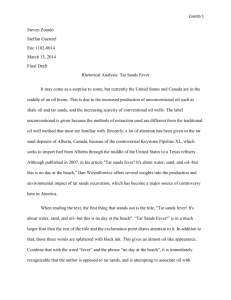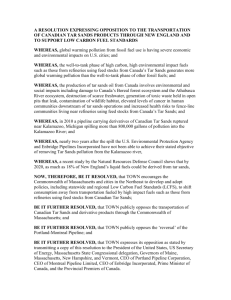4.1 Energy & Mineral Resources / 4.2 Alternate Energy Sources
advertisement
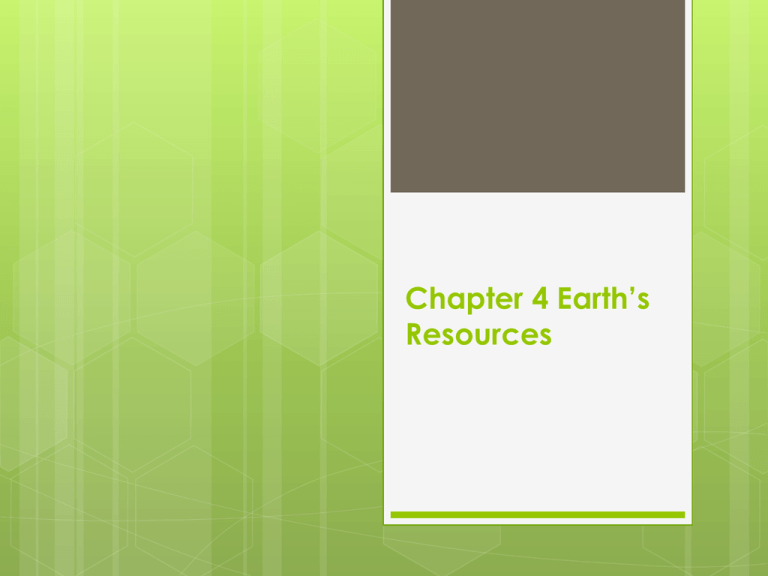
Chapter 4 Earth’s Resources 4.1 Energy & Mineral Resources Renewable vs. Nonrenewable Resources A renewable resource can be replenished over a short period of time (Months, years, or decades) A nonrenewable resource takes millions of years to form and accumulate Examples Renewable Plants for food Animals for food Natural Fibers for clothing Trees for lumber/paper Water Wind Sun Non - Renewable When the current supply run out there will not be anymore Why is this a problem? Fossil Fuels Coal Oil (Petroleum) Natural Gas Fossil Fuels Any hydrocarbon that may be used as a source of energy Coal Primarily used to generate electricity Scars the land Dangerous Air pollution (High Sulfate) Petroleum Natural Gas Oil trap – geological structure that allows large amounts of fluids to accumulate Stops upward movement of oil and gas Tar Sands & Oil Shale Some energy experts believe that fuels coming from tar sands and oil shales could be good substitutes for lowering petroleum supplies Tar sands are mixtures of clay & sand combined with water 7 black tar The oil in tar sands are not easily pumped out Problems Land disturbance Lots of water Contaminated water Oil Shale is a rock that contains a waxy mixture of hydrocarbons called kerogen. Oil Shale is heated to vaporize kerogen Kerogen vapors are processed to remove impurities Around half of the world’s supply is in the Green River Formation of Colorado, Utah, & Wyoming Problem? YES b/c of lower water amounts in the Green River Formation Formation of Mineral Deposits Important mineral deposits form by igneous processes & from hydrothermal solutions Igneous processes produce important deposits of metallic minerals Hydrothermal solutions generate important ore deposits Placer Deposits form when eroded heavy materials settle fast from moving water while less dense particles remain still and settle Nonmetallic Mineral Resources Extracted & processed either for the nonmetallic elements they contain or for their physical & chemical properties Ex) Fluorite & Limestone Two Groups Building Materials Industrial Minerals Not abundant as building materials 4.2 Alternate Energy Sources Solar Energy 2 advantages – “fuel” is free & non-polluting Passive Solar Collectors (south-facing windows) Roof top devices Heat water Photovoltaic (Solar) Cells = electricity Problems? Equipment is not cheap Supplemental unit needed https://www.youtube.com/watch?v=dngqYjHfr98 https://www.youtube.com/watch?v=eINAuYg-ftM Nuclear Energy Nuclear fission, the nuclei of heavy atoms are bombarded with neutrons. The nuclei split into smaller nuclei & emit neutrons and heat energy Cost is high Dangerous Accidents with radioactive materials https://www.youtube.com/watch?v=_Uw exvaCMWA Wind Energy Sailing Ships Windmills 1980 Federal Govn’t started wind program systems Estimate that the next 50-60 years, wind power could meet btw 5-10 % of the country’s demand for electricity https://www.youtube.com/watch?v=EYY HfMCw-FI Geothermal Energy Hot water is used directly for heating and to turn turbines to generate electric power Underground reservoirs of steam and hot water are tapped into Not expected to provide a large % of the growing needs for energy https://www.youtube.com/watch?v=rfUQy86 ZMpQ https://www.youtube.com/watch?v=uVDBRQ vBVso Hydroelectric Power Falling Water = energy The water held in a reservoir behind a dam is a form of stored energy that can be released through the dam to produce electric power Water is renewable but the dam has a limited lifetime https://www.youtube.com/watch?v=rnPEt wQtmGQ Tidal Power Ocean’s energy potential is still untapped Harnessed by constructing a dam across the mouth of a bay or estuary in coastal areas. The strong in – out flow that results drive the turbines & electric generators https://www.youtube.com/watch?v=tSBA CzRE3Gw

